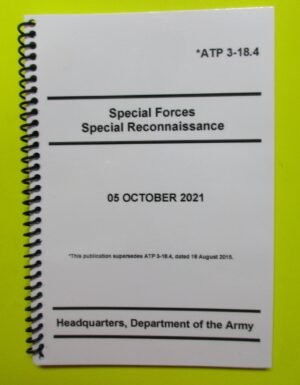dated 26 June 2015 (This book replaces FM 3-75, Ranger Operations dated 2012)
ATP 3-75, Ranger Operations, establishes doctrine for Ranger operations. It describes Ranger roles, missions, capabilities, organization, mission control, employment, and sustainment operations across the range of military operations. This manual is a continuation of the doctrine established in the JP 3-05 series and FM 3-05.
The principal audiences for ATP 3-75 are special operations forces (SOF), joint, and land component force commanders and staff. This publication provides a broad understanding of Ranger operations and provides guidance for commanders who determine the force structure, budget, training, materiel, operations, and sustainment requirements necessary to prepare Ranger units to conduct their missions.
ATP 3-75 applies to the Active Army, Army National Guard/Army National Guard of the United States, and the United States Army Reserve unless otherwise stated.
Introduction
ATP 3-75 (formerly FM 3-75) was last published in 2012. This revision provides updates to the Ranger Regiment organization, current Army terminology, and references used. This publication provides doctrinal guidance on the organization and capabilities of Army Rangers and outlines the necessary requirements for conducting, planning, preparing, and executing Ranger missions. ATP 3-75 is composed of nine chapters, which are summarized below.
Chapter 1 provides an overview of the Ranger Regiment. This chapter describes how Rangers are tasked, organized, and globally employed.
Chapter 2 discusses how Ranger units are structured at every echelon. It also discusses Ranger force modernization efforts.
Chapter 3 describes how Rangers operate when assigned under a joint special operations task force (JSOTF) or joint task force (JTF). Various command relationships are discussed with particular emphasis on the most typical.
Chapter 4 discusses unique Ranger communications requirements, planning considerations, and capabilities. This chapter also discusses Ranger communication limitations and the external support necessary to expand capabilities when needed.
Chapter 5 describes Ranger intelligence tasks, roles, organization, and targeting activities in support of Ranger operations. It also discusses intelligence support provided to subordinate units as well as support required from higher echelons.
Chapter 6 discusses employment, movement, and maneuver of Ranger units. It discusses deployment options, deployment planning, and how Rangers support the National Military Strategy. A special operations task force (SOTF) description has been added to illustrate how Ranger units might be configured when deployed.
Chapter 7 provides a brief discussion of regimental fires to include assigned fire support planners, organic weapons, and external support. This chapter also discusses special operations aviation, Civil Affairs (CA), and military information support (MIS) to Ranger operations.
Chapter 8 provides a brief overview of threats to Ranger units and Ranger protection planning. It covers topics such as force health protection, medical evacuation, and religious support.
Chapter 9 discusses sustainment for the regiment to include logistics planning, preparations, and the capabilities of organic support elements. Various methods of resupply are discussed as well as required external logistics support.
This book is a “mini” size (half the size of a regular sheet of paper).
– A popular size to carry anywhere (briefcase, large pocket, purse) but the print is large enough for easy reading. The binding is with coil, allowing easy flipping of pages without jamming.
The color covers are laminated for weather protection with black and white inside printing.
(A BIG size version (8 1/2 inch by 11 inch, the same size as a regular sheet of paper) is on this website too)





